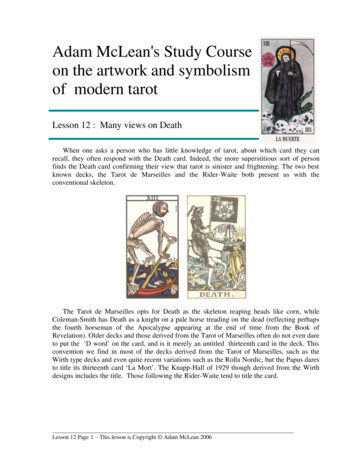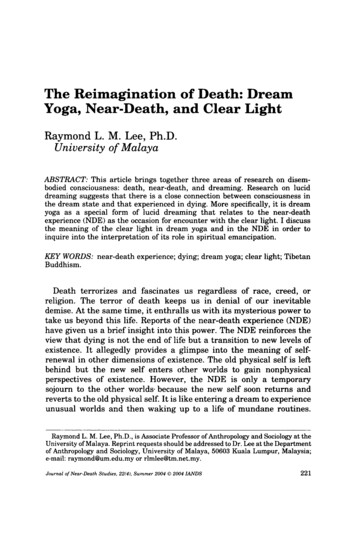
Transcription
The Reimagination of Death: DreamYoga, Near-Death, and Clear LightRaymond L. M. Lee, Ph.D.University of MalayaABSTRACT: This article brings together three areas of research on disembodied consciousness: death, near-death, and dreaming. Research on luciddreaming suggests that there is a close connection between consciousness inthe dream state and that experienced in dying. More specifically, it is dreamyoga as a special form of lucid dreaming that relates to the near-deathexperience (NDE) as the occasion for encounter with the clear light. I discussthe meaning of the clear light in dream yoga and in the NDE in order toinquire into the interpretation of its role in spiritual emancipation.KEY WORDS: near-death experience; dying; dream yoga; clear light; TibetanBuddhism.Death terrorizes and fascinates us regardless of race, creed, orreligion. The terror of death keeps us in denial of our inevitabledemise. At the same time, it enthralls us with its mysterious power totake us beyond this life. Reports of the near-death experience (NDE)have given us a brief insight into this power. The NDE reinforces theview that dying is not the end of life but a transition to new levels ofexistence. It allegedly provides a glimpse into the meaning of selfrenewal in other dimensions of existence. The old physical self is leftbehind but the new self enters other worlds to gain nonphysicalperspectives of existence. However, the NDE is only a temporarysojourn to the other worlds- because the new self soon returns andreverts to the old physical self. It is like entering a dream to experienceunusual worlds and then waking up to a life of mundane routines.Raymond L. M. Lee, Ph.D., is Associate Professor of Anthropology and Sociology at theUniversity of Malaya. Reprint requests should be addressed to Dr. Lee at the Departmentof Anthropology and Sociology, University of Malaya, 50603 Kuala Lumpur, Malaysia;e-mail: raymond@um.edu.my or rlmlee@tm.net.my.Journal of Near-Death Studies, 22(4), Summer 20042004 LANDS221
JOURNAL OF NEAR-DEATH STUDIES222Unlike dreaming, however, the NDE empowers a radical transformation in a person's life.In a contemporary spiritual classic The Tibetan Book of Living andDying, the Tibetan lama Sogyal Rinpoche (1992) devoted an entirechapter to the NDE (pp. 319-336). He explained that his teacher,Dilgo Khyentse Rinpoche, referred to the NDE as belonging to the"natural bardo of this life" (that is, our lifetime between birth anddeath) because the consciousness of the near-death experiencer(NDEr) was still tied to this world and wandering temporarily inother realms. Moreover, the NDEr was merely standing on thethreshold of the other bardos without actually entering them andreturningto thislife (Rinpoche,1992).Accordingto TibetanBuddhist teachings, the bardos are the intermediate states experienced during and after dying (Rinbochay and Hopkins, 1979; LamaLodo, 1987).By comparing the NDE to the bardo states, Rinpoche (1992) came tosee many similarities between the NDE and the bardo of becoming(Sipai Bardo), the bardo that occurs just before a deceased persontakes rebirth in one of six realms (gods, demigods, humans, animals,hungry ghosts, and hell beings). These similarities include out-of-bodyexperiences, invisibly watching living relatives, clairvoyance, meetingdead people, and so on. Like the deceased person, the NDEr is exposedto the clear light or ground luminosity (dharmakaya)but if he or she isnot trained to recognize it as the natural or primordial mind, then theexperiencer will not attain ultimate liberation. The deceased personmoves on to other bardo states and eventually takes rebirth in one ofsix realms. The NDEr, on the other hand, returns to the human realmbut does not forget the encounter with the clear light. Rinpoche (1992)explained that the clear light is the all-encompassing space of truththat is beyond birth and death, signaling the supreme moment forliberation from all worldly existence. His explanation suggests thatthe NDE does not represent a merging with the clear light; otherwiseit would not be considered an NDE but a death experience resultingin liberation.Since the NDE is, according to the Tibetan Buddhist perspective,merely a peripheral experience of death and the clear light, it isactually like an unplanned expedition into the bardo realms. For thatreason, such an experience is somewhat akin to dreaming where thedreamer wanders into uncharted territories of consciousness. In fact,Rinpoche (1992) pointed out that "How your mind is in the sleep anddream state indicates how your mind will be in the corresponding bardo
RAYMOND L. M. LEE223states. . This is why the yoga of sleep and dream plays such animportant part in the preparation for death" (p. 108). In other words,there is something about dreaming and near-death that connects to theconsciousness in dying.We often hear of people dying in their sleep as if they departed intheir dreams. If these people had generally been in good health andthere was no specific medical reason for their deaths, the most logicalconclusion would be their hearts stopped functioning; that is, theyexperienced a fatal heart attack while asleep. Assuming that theirconsciousness was not interrupted by the trauma of heart failure,would this suggest that their consciousness in dreaming could haveconverged with their consciousness in dying? If we take all the studiesof the NDE as plausible evidence for the survival of consciousnessafter death, we can reasonably speculate that the state of mind indying and that in dreaming are of the same mental continuum sinceboth are consequences of the disembodiment of consciousness.In our everyday lives, we tend not to make any connection betweendreaming and dying. Rather, we expect to awake from dreaming butnot from dying. This expectation is ingrained in most people because ofthe naive assumption that death marks the end of consciousness andtherefore cannot be seen as continuous with dreaming. The NDEprovides a very strong case against such an assumption. Since theNDE demonstrates the dynamism of consciousness without activesupport of the physical body (Sabom, 1998), it is not too farfetched toimagine its parallel with dreaming which is possible only underconditions of physical inertness. The stilling of the physical body innear-death and sleep is, perhaps, a necessary condition for theincreased activation of consciousness to levels not usually experiencedin ordinary waking life. This is not a new observation. In manyshamanic cultures, dreaming and dying are not sharply distinguishedto produce a compartmentalized view of life and death. Shamans inthese cultures may enter a trance comparable to an NDE for severalhours or days in order to empower their consciousness to reach otherrealms of existence (Eliade, 1964).What makes near-death comparable to dreaming is that bothphenomena are experienced under conditions in which reality isperceived without reference to the physical body. The consciousness ofthe NDEr and dreamer continues to function, perhaps even in anenhanced mode, as if it were totally independent of the physical body.This apparent separation between body and mind in the NDE anddreaming suggests the possibility of disembodied consciousness as an
224JOURNAL OF NEAR-DEATH STUDIESalternative source of reality formation. Parallels between the NDEand dreaming can be thought of as the perception of reality bydisembodied consciousness not dissimilar to the Tibetan Buddhisttheory of bardo consciousness. The aim of this article is to explorethese parallels in order to address the continuity of states of mindexperienced in waking life, dreaming, and dying.The Stuff of DreamsLike death, dreams fascinate and terrorize human beings. We areintrigued by the surreal nature of dreaming and frightened bynightmares. This ambivalence toward dreaming is partly influencedby the way the modern mind bifurcates consciousness into a wakingstate defined as the embodied reality and a dreaming state construedas far from real.The Freudian analysis of dreams exemplifies this bifurcation (Freud,1954/1900). Dreams represent the unspoken, repressed aspects of thewaking state. They are formed in the unconscious moments of sleep,their contents derived from inexpressible desires not monitored by thesleeping mind. Unlike the rational processes of the waking state,dreaming disguises all sorts of thoughts that seek expression duringthe mentally unguarded hours of sleep. These thoughts includea combination of recent and distant memories of events that arewarped in such a way as to give unconditional release to repressedimpulses in circumstances where consciousness cannot function asa watchdog. Thus, dreaming is not considered real in the sense that thedream referents, while grounded in the events of waking life, are notlogically related as in the mundane relations of everyday life. Putanother way, dreams are bizarre movies about our hidden motives inthe ordinary waking world. Fascination with dreams is, therefore,a way of dealing with the meaning of dreams for the accomplishment ofsocial relationships in the physical world. But the terror of dreaming,especially nightmares, lies in the unreal or surreal nature of dreamingwhere control is lacking for interpreting or manipulating events.This type of theorizing about dreams has already been challenged bythe work of David Foulkes and other dream researchers in the 1960s(Foulkes, 1964). Basically, the challenge lies in the contention that it isnaive to assume clearly discrete moments of pristine conscious activityas found in the waking state and of vague, unrealistic thoughtprocesses as found in the dreaming state. Research from that period
RAYMOND L. M. LEEsuggests that differences225in consciousnessbetween wakingandsleeping moments cannot to be taken as absolute. In the words ofFoulkes (1964, p. 240): "Apparently no pointexists, in the sense that there is no point inconsciousness suddenly appears. It seemsEmpirical findings from this research haveof absolute dream onsetthe sleep cycle at whichto be there all along."shown that backgroundthoughts in waking experience come to life as dreams not during rapideye movement (REM) sleep but rather in non-REM sleep, in the periodpreceding REM sleep associated with fertile dream activity. However,dreaming in early REM sleep may contain distorted elements ofwaking experience but not necessarily related to unfulfilled desires orpersonal problems. In short, dreaming is a complex unfolding ofconsciousness in multiple directions that are not yet fully understood.In the light of the above challenge, the question of dreamconsciousness has become even more intriguing because we can nowask whether dreams can be manipulated at will, since the differencebetween waking and dreaming moments need not be perceived asabsolute. Charles Tart, a well-known psychologist in sleep and dreamresearch, reported a type of dream he called "high dream" thatdissolved boundaries between sleep, dreaming, and waking. Tartdefined the "high dream" asan experience during sleep . in which you recognize during thedream that you are in an altered state of consciousness which issimilar to (but not necessarily identical with) the high induced bya chemical psychedelic. It is important to emphasize that it is not thecontent of the dream, but what is dreamed about that distinguishesthe high dream from the ordinary dream: one could dream of takingLSD, e.g., without the change in the mental processes that constitutethe high dream, just as one can dream of waking up without it beinga lucid dream. (Tart, 1972, p. 174).This state of high feeling may not vanish at the end of dreaming butactually carry over into the waking state. To what extent a high dreamcan be manipulated by a dreamer who is aware of the condition is anarea open to investigation.Although a high dreamer may recognize his or her peculiarcondition, it is the lucid dreamer who simultaneously becomes awareof dreaming and involved in testing and changing the dreamenvironment. Lucid dreaming differs from the high dream in theway rationality spontaneously enters the dream state to affect thedreamer's perception so clearly that the dreamer is not only awake inhis or her dreams, but is also emotionally high without necessarily
226JOURNAL OF NEAR-DEATH STUDIESmaking any reference to chemical psychedelics or hallucinogens.Waking up in one's dreams introduces a type of consciousness that isexhilarating and receptive to the continuity between sleeping andwaking. There is a growing literature in this field of dream researchand practice (Green, 1968; Green and McCreery, 1994; LaBerge, 1985;LaBerge and Rhinegold, 1990). What is important to note in thisliterature is the emphasis on the high degree of freedom available tothe dreamer to test and change the dream scenarios. Lucid dreamingopens up new dimensions of consciousness previously unknown tomost people who assume dreaming to be unreal or lacking insubstance as compared to the embodied experiences of waking life.The quest for lucid dreaming is, on the one hand, a concerted effort tomaster the intricacies of inner space and, on the other hand,a continuing search for the meaning of higher consciousness.Mastering inner space has been a long-standing goal of humankindto probe and control the workings of the mind through various mysticaland shamanic techniques. There is no systematic science of inner spacein the same sense that one speaks of a medical science, physicalscience, or behavioral science. Because the mechanism of inner spacedraws upon the subtle qualities of the mind, any attempt to understandand manipulate it cannot be privileged by reductio ad absurdummethodologies. One cannot prove the falsity of walking througha mountain in a dream any more than one can disprove water isliquid. In other words, mastery of inner space does not comprise anexact science in the same manner as the methodologies of the naturalsciences. For that reason, lucid dreaming is more appropriately definedas an art of dreaming that activates new patterns of mindfulness orawareness reaching into the unconscious.In a lucid dream that I experienced, I was walking on a narrowgarden path surrounded by high walls with no exits. As soon as Ibecame aware that I was dreaming, I told myself that I should be ableto walk through the wall. On my first attempt I knocked myself againstthe wall. Then I tried a different approach. I closed my eyes, relaxedand merged with the wall. I felt myself going through the wall, mydream body tingling with a strange sensation. Then I was on the otherside of the wall. I was on a busy street and it was night. In becominglucid I attempted to test the dream environment, as suggested byresearchers of lucid dreaming, to assess the new levels of freedom inmovement. Walking through walls was indeed a way of masteringinner space by experimenting with the newfound potential of disembodied consciousness.
RAYMOND L. M. LEE227The exploration of inner space through lucid dreaming providesa new view of reality concealed from the embodied perspectives ofwaking life. This new view of reality does not imply that the dreamworld is more real than the ordinary world in waking life. Rather, itdemonstrates that a radical change in consciousness redefines the verynature of reality. Awakening in a dream leads to another level ofconsciousness that can turn surrealism into a living experience, just asbeing in a stupor has certain experiential consequences in waking life.A task of lucid dreaming is to attain realization of consciousness as anindependent variable capable of penetrating the constructed nature ofreality. The lucid dreamer should come to realize that walking throughwalls in a dream merely represents a way in which disembodiedconsciousness apprehends dream reality. This too is the aim of dreamyoga, the technique for manipulating dreams in order to achieve a stateof mind that transcends the compartmentalization of consciousness. Inrecent years, dream yoga of the Tibetan Buddhist variety has receivedwide attention (Norbu, 1992; Rinpoche, 1998). The Tibetan practice ofdream yoga is not only meant to develop mindfulness in dreaming butalso to rehearse for the moment of death. In Tibetan Buddhistteachings, there is a correspondence between sleeping, dreaming anddying. Thus, knowing how to dream provides the basis for knowing howto die. Manipulation of dreams is secondary to the higher goal ofdirecting consciousness toward the clear light of death.Dream Yoga and Clear LightDream yoga comprises special techniques for training the mind todevelop awareness in dreaming in order to attain spiritual liberation. Itis a method of meditation for cultivating disembodied consciousness toreach a state of realization that recognizes the clear light of sleep. Inthe Tibetan Buddhist system, sleep is regarded as analogous to deathsince it is taught that the primordial mind manifests as clear lightduring sleeping and dying moments. Although the clear light manifestsin sleep, it is not considered as profound as the clear light encounteredin death. According to the Dalai Lama,the clear light of sleep is not as deep as the clear light of death.Vajrayana [Tantric] Buddhism speaks of five primary and fivesecondary types of vital energy, as well as gross and subtle aspectsof these two sets of five. In the clear light of sleep, the grosser forms ofthese various energies dissolve, or withdraw, but the subtle forms donot. (Varela, 1997, p. 44)
JOURNAL OF NEAR-DEATH STUDIES228In other words, practicing dream yoga to experience the clear light ofsleep is a preparation for the more profound recognition of the clearlight of death, when all the vital energies dissolve.In this system of meditative realization, attaining the state of clearlight is considered the highest spiritual goal because the clear light isasserted to be the ultimate reality that frees us from all worldlyillusions and delusions. The doctrine of the clear light forms part of theYogini or Shakti Tantras, which is traceable to Lawapa of Urgyan (nowa region in Afghanistan) and later to Padmasambhava who introducedBuddhism to Tibet in the 8 th century (Evans-Wentz, 1958). The clearlight has been described in the following terms by Walter Evans-Wentz(1958, p. 166): "As being colourless, without qualities, It is the ClearLight; as being without limitations, It is All-Pervading Intelligence; asbeing unknowable in terms of sangsdric [phenomenal] consciousness,and without form, It is the Formless Void." Furthermore, Evans-Wentzexplained that the clear light is momentarily experienced by all humanbeings at the time of death, but for Buddhas and masters of yoga theexperience of clear light can be willed and maintained indefinitely.From the soteriological point of view, the opportunity to cultivaterealization of the clear light while alive should not be ignored becausein death this realization would not be available for the untrained mind.The clear light also manifests in sleep but it is generally not noticedby the ordinary mind. The purpose of dream yoga is to awaken thesleeping mind in order to cut through the illusory nature of dreams,thus preparing the dreamer to encounter the clear light of sleep. In thewords of the Dalai Lama:In Tantric Buddhism or Vajrayana, there are four stages in theprocess of falling asleep, culminating in the so-called clear light ofsleep. . [A] person who is well trained in Vajrayana meditation canrecognize a strict order in these four states of falling asleep, and is.well prepared to ascertain an analogous order in the dying process.If you can recognize the dream state while in it, then you canvisualize and deliberately reduce the grosser level of mind to returnagain to clear light sleep. At that point the subtlest level of mind-theclear light of sleep - is easier to ascertain. (Varela, 1997, p. 40)More specifically, the Dalai Lama pointed out that:The main purpose of dream yoga in the context of tantric practice is torecognize the dream state as dream state. Then, in the next stage ofthe practice you focus your attention on the heart center of yourdream body and try to withdraw the vital energy into that center.
RAYMOND L. M. LEE229That leads to an experience of the clear light of sleep, which ariseswhen the dream state ceases. (Varela, 1997, p. 129)The Dalai Lama's exegesis on dream yoga is congruent with thedoctrine of dreams as explicated in the Yogini Tantras. As EvansWentz (1958, p. 166) put it, "The whole purpose of the Doctrine ofDreams is to stimulate the yogin to arise from the Sleep of Delusion,from the nightmare of Existence, to break the shackles in which mdyd[illusion] thus has held him prisoner throughout the aeons."Hence, dream yoga as taught in these tantras is meant to train thepractitioner to realize the dream state is no more illusory than thewaking state. Once the practitioner is able to cut through the inauthenticity of both these states, realization of the clear light becomes possible:By concentrating the mind upon the forms of the deities seen in thedream-state, and by keeping the mind free of thoughts, in thequiescent condition, the forms of the deities are attuned to the nonthought condition of mind; and thereby dawneth the Clear Light, ofwhich the essence is of the Voidness. (Evans-Wentz, 1958, p. 222)In the contemporary practice of dream yoga, techniques are taughtnot only for realizing the illusory nature of dreams, but moreimportantly to gain awareness of the clear light. For instance, NamkhaiNorbu, a Tibetan master of the Dzogchen tradition, emphasized thatdeveloping clarity in dreaming helps to generate awareness of thenatural light, which is similar to the clear light:In the practice we do, there has to be an awareness of, or mastery of,the state of natural light. When one has an awareness of the presenceof this state of natural light, then even if afterwards the state ofdreams arises, one spontaneously becomes lucidly aware that one isdreaming while dreaming, and automatically one achieves mastery ofone's dreams. This means that the dream does not condition theperson, but the person governs his or her dream. For this reason, thepractice of dreams is secondary, and I cannot overemphasize howextremely important it is to do the practice of the natural light.(Norbu, 1992, pp. 48-49)The reason for his emphasis on the practice of the natural light indreaming has to do with familiarizing oneself with the "mother light"or the clear light encountered in death. Thus, dream yoga preparesa person to gain instant recognition of the clear light at the moment ofdeath, even though that person may not have achieved completespiritual realization while alive. But practicing dream yoga in order to
230JOURNAL OF NEAR-DEATH STUDIESestablish some familiarity with the clear light is said to be an arduousprocess. A practitioner can develop awareness of the clear light onlywhen he or she has become adept in non-dual perception, that is theability to perceive without reference to a subject-object relationship.Tenzin Wangyal Rinpoche, a lama in the Bon tradition of Tibet, hadthis to say about non-dual perception in dream yoga:The clear light is generally spoken of in the teachings about sleep yogaand indicates a state free from dream, thought, and image, but there isalso a clear light dream in which the dreamer remains in the nature ofmind. This is not an easy accomplishment; the practitioner must bevery stable in non-dual awareness before the clear light dreamarises. . The clear light dream, while emerging from the karmictraces of the past, does not result in dualistic experience. Thepractitioner does not reconstitute as an observing subject in relationto the dream as an object, nor as a subject in the world of the dream,but abides wholly integrated with non-dual rigpa [awareness].(Rinpoche, 1998, pp. 63-64)Although Tenzin Wangyal Rinpoche construed a difference betweenthe clear light of sleep and clear light dream, it is likely to be a differenceof degree, in which the clear light dream represents a deeper experienceof the clear light of sleep. To be able to remain in the nature of mind asa clear light dreamer suggests that the practitioner would face few or noobstacles in meeting the mother light at the moment of death.Compared to dream yoga, lucid dreaming lacks spiritual directionsince it is mainly concerned with manipulating the dream environmentand not with training to recognize the clear light. A lucid dreamer isone who recognizes the dream as a dream but not necessarily themanifestation of clear light. Only by further training in dream yoga cana lucid dreamer possibly advance into the stages of clear lightrecognition. In short, dream yoga accomplishes what lucid dreamingcannot by actualizing awareness of the clear light and its variantexpressions (mother light, clear light dream) as a rehearsal for deathwhen the practitioner can gain complete liberation.How is dream yoga related to the NDE? The experience of light iscommon to both dream yoga and the NDE. In dream yoga, however,the clear light represents the final stage in a yogic effort to recognizethe nature of mind, whereas the experience of light is a serendipitousevent in the NDE. In the literature on NDEs, no one has compared theexperience of light to the clear light of sleep. In fact, most NDErs whohave had such an experience referred to it as a divine light or a beingof light. This difference with dream yoga needs further exploration.
RAYMOND L. M. LEE231Near-Death and the Experience of LightPediatrician Melvin Morse wrote: "The Light is the key element ofthe NDE" (Morse and Perry, 1990, p. 117), and yet brain researchershave not come close to explaining it. Like other near-death researchers,he wanted to know the location of the light experienced by manyNDErs. Was it outside the body or within the brain? From his ownresearch, he came to the conclusion that the light was located outsidethe NDEr's body. He ended his chapter on the pure light by writing: "Iwould like to believe that the Light is where we go when we die. Likea birth into a bright new world, the Light of the NDE represents thebeginning of a new beginning" (Morse and Perry, 1990, p. 134).Morse's optimistic conclusion focuses on the relationship betweenthe NDEr and the light in dualisticterms. According to hisinterpretation, the experience of light in an NDE is alleged to occurexternally, as if the experiencer as subject is separate from butperceptually responsive to the light as an object of visualization andaffective attachment. Unlike dream yoga, which cultivates a non-dualawareness of the clear light, this type of interpretation in near-deathresearch advances understanding of the light experience withoutinquiring into the basis for identifying it as an external source. MarkFox warned against this unexamined assumption:.In one crucial sense . oversimplistic attempts to claim definitiveinterpretations and identifications of NDE motifs . say more aboutthe identity of those doing the identifying than about the identity ofthe light itself.Indeed, as regards the light's identity, we cannot even .attempt to identify it by function, for it appears to do a number a destination, sometimes lighting the way, sometimes judging,sometimes asking questions, and sometimes simply returning NDErsto where they came from. (Fox, 2003, pp. 139-140)Even Fox himself seemed to treat the light as an external object, sincehe interpreted its multiple role as acting on the NDEr rather thanbeing part of the NDEr's own identity.In dream yoga, non-dual awareness of the clear light implies thatthe practitioner does not perceive the light as being somewhere outthere to be apprehended and recognized. Such awareness is internallyself-contained, so no need arises to identify the light as somethingdiscrete and having a role or many roles to fulfill at that particularmoment. Instead, an advanced practitioner would see no difference
232JOURNAL OF NEAR-DEATH STUDIESbetween his or her mind and the clear light once the recognition ismade. The differentiation between the practitioner's consciousnessand the clear light collapses when the practitioner's own realization nolonger supports the subject-object distinction in meditation. This isconstrued as the yogic liberation of mind that is no longer conditionedby dualistic categories. The mind of the practitioner becomes the clearlight itself. Does this mean that the clear light experience in dreamyoga is not the same as the experience'of light in the NDE?Since there is no direct correspondence between the NDE and dreamyoga, one might be inclined to argue that the light of the NDE might notbe experientially similar to the clear light encountered by thepractitioner of dream yoga. Yet the experience of light is central toboth the NDE and dream yoga, this experience being the connectinglink to the clear light that supposedly manifests at the time of death.Unlike the NDEr, the practitioner of dream yoga trains to recognize theclear light in order not to be distracted at the moment of death andforgo the opportunity for spiritual liberation.The NDEr, on the other hand, is not likely to be a dream yogi, andtherefore has no prior knowledge of the clear light. The dualisticinterpretation given by most NDErs to their experience of light as anencounter with a divine being suggests the absence of training that onefinds in dream yoga for developing a non-dual awareness of the clearlight. Such awareness does not necessarily result in an attribution ofdivinity to the light, but brings to attention the lack of distinctionbetween the mind of the practitioner and the clear light. Unless theNDEr has had some prior training in non-dual recognition of the clearlight, the experience of light would merely constitute an instance ofineffable awe and emotional ef
experience (NDE) as the occasion for encounter with the clear light. I discuss the meaning of the clear light in dream yoga and in the NDE in order to inquire into the interpretation of its role in spiritual emancipation. KEY WORDS: near-death experience; dying; dream yoga; clear light; Tibetan Buddhism.Cited by: 1Publish Year: 2004A
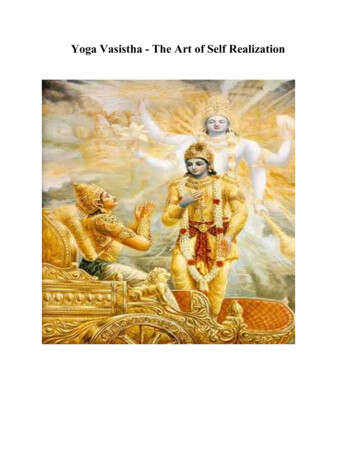
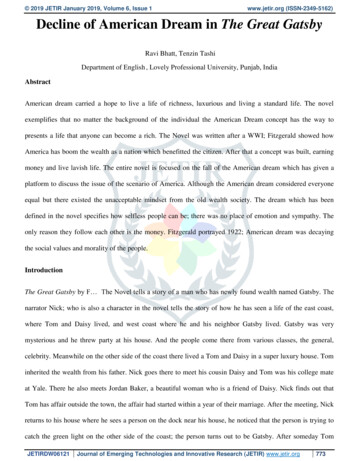
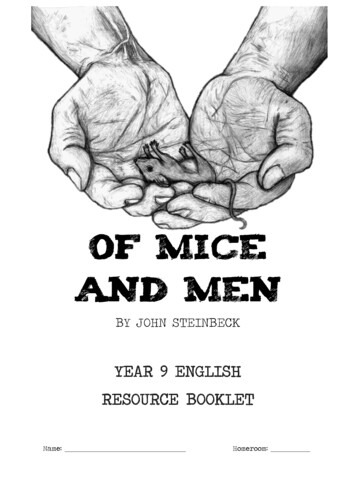
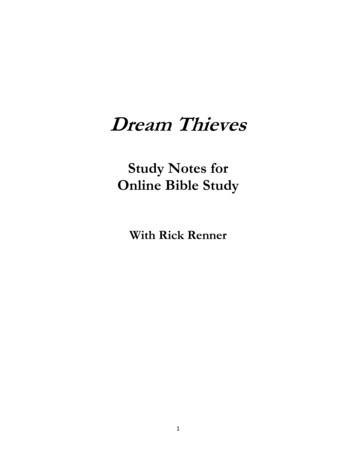
![Requiem For The American Dream [Transcript]](/img/13/requiem-for-the-american-dream-transcript.jpg)
